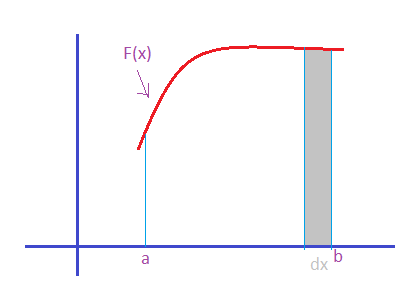Definite Integrals
Fundamental Theorem of Calculus: It states that the sum of small changes in any quantity over a period of time adds up to the total quantity.
In the below figure I have shown the function F(x) and I need to find the area of the above curve I take the bounded values of the curve a and b start
summing up taking the small values of dx considering a small rectangle and extending the same area throughout the curve.
This is taken as the integral for the whole area under the curve between the limits a and b.
So fundamental theorem takes the form
$\int_{a}^{b}(F(x)dx$ = F(b) - F(a) to find the area under a curve.
F(x) is the integral of f(x);
F(b) is the value of the integral at the upper limit, x=b; and
F(a) is the value of the integral at the lower limit, x=a.
This expression is called a definite integral.

So it clearly says the area can be found out using the above integral and is also known as definite integral.
Applications of Definite Integrals
Its usage can be seen in a vast number of applications such as finding the volume of solids of revolution, area enclosed between two curves and integral as sum of limit.
Properties of Definite Integrals
Consider 2 functions f(x) and g(x) which are continues functions then
$\int_{a}^{b} (f(x)+g(x))=\int_{a}^{b}f(x) + \int_{a}^{b} g(x)$
$\int_{a}^{a}f(x)=0$
$\int_{a}^{b}f(x) = \int_{a}^{d}f(x)+\int_{d}^{b}f(x)$
$\int_{b}^{a}f(x)= -\int_{a}^{b}f(x)$
For arbitrary numbers a and b and d belongs to [a, b].
Definite Integrals Solved Problems
Example 1: Find the integral and then write the upper and lower limits with square brackets, as follows:
$\int_{2}^{3}(5x^{4})+2x+6$
[x 5 + $x^2$ + 6x] 2, 3
The upper and lower limits are written like this to mean they will be substituted into the expression in brackets.
Next, substitute 5 (the upper limit) into the integral:
[(2-3)5 + (2-3) 2 + 6(2-3)]= -1 +1+ 6(-1) = -6
Example 2: Find the integral $\int_{1}^{2}(5+7x^{6})$
Solution : $\int_{1}^{2}(5+7x^{6})$
5x + x7
$5(2-1) + (2-1)^7$
5 + 1 = 6
Example 3: Find the work done if a force F(x) = 5x - 3 N is acting on an object and moves it from x = 1 to x = 6.
Solution: $\int_{1}^{6}(5x-3)$
[$5x^2 - 3x$]
$5(6-1)^2 - 3(6-2)$
125 - 12
113 joules.
Example 4: The expression, v, for velocity in terms of t, the time, we can find the displacement S of a moving object from time t = 0 to time t = 6 by integration is given by $\int_{0}^{6}(v dt)$
If V is given by t2.
Then [$\frac{t^3}{3}$] (After integrating)
216/18 unit/sec.
Average Acceleration Calculator
Average acceleration is the object's change in speed for a specific given time period. ...
When an object falls into the ground due to planet's own gravitational force is known a...
In Mathematics, the permutation can be explained as the arrangement of objects in a particular order. It is an ordered...
A rectangle can be explained as a 4-sided quadrilateral which contains equal opposite sides. In a rectangle
A three sided polygon which has three vertices and three angles is called a triangle. Equilateral triangle...





